
Croatian Gastronomy
.pdf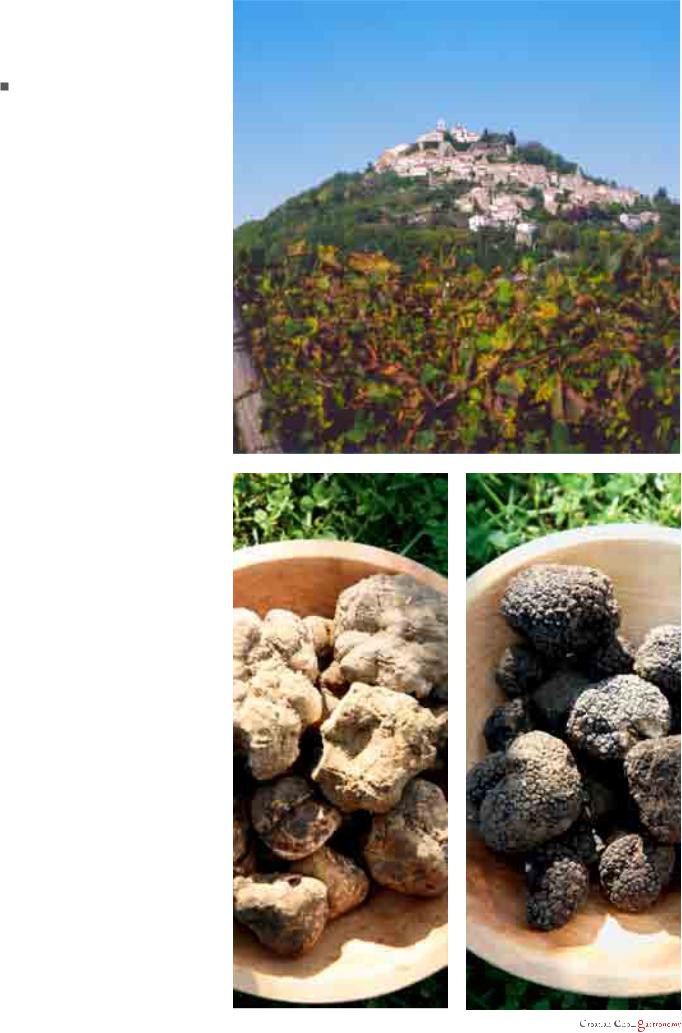
health
Istria is a Croatian region, surrounded by the sea, thus its cuisine is mostly based on the fruits of the sea. Change of seasons and the Mediterranean climate, as well as the conditions at sea, dictate the type of seafood to be chosen at a given time. Plenty of fresh fish and famous shrimps are available for most of the year and they are a perfect choice for a healthy heart, particularly the Omega 3 fatty acids, obtained from seafood which protect the heart and vascular system.
Zinc (Zn), the mineral found amply in seafood, is of vital importance for the immune system. The amount of zinc in the body is related to vitality and replacement of lost energy; revitalisation.
Shells, limpets and fish are surely the primary choices in Istria, for they are full of minerals.
Exotic taste and an extravagance of truffles are a temptation for all those ready for a gastronomic adventure.
A strong point in the gastronomy of Istria is made by olive oil, which presents a perfect choice for energy and good health.
groceries
Goat cheese Brill Truffles
Istrian proscuitto
dishes
Fritaja (a type of omelette)
Pljukanci (home-made Istrian pasta) with asparagus and truffles
Bitter orange cake
Bouillabaisse (brudet) of drysmoked octopus
Fried shark
20

wi n e s
Istria is the largest peninsula in Croatia and its most western winegrowing region. Its geographic position is excellent, and is almost fully surrounded by the sea. It has a mild Mediteranean climate, with significant continental influences. This area is also very interesting and diverse from the geopolitical view; it is situated within three states, between the east and the west, in touch with many different peoples and on a crossroads of different cultures. Its rich and turbulent history, Istria nowadays uses to its advantage
– it is a multi-cultural environment, open and progressive in many segments of human life and work.
All of that had its impact on the development of vineyards and wine-growing, the history of which dates far into ancient times. It is thought that the first vine was brought by the Greek colonists, several centuries before Christ. Istrian viticulture was developing through the centuries and its peak occurred at the end of the 19th century, together with other parts of Croatia, before the appearance of the vine-pest. Today, Istria is one of the most important Croatian winegrowing areas. Wine is not only an important agricultural product, but also an integral part of the tourist offer. As proof of this, everyone who comes to Istria by car can see; after passing the 5 km long tunnel through the Učka Mountain, one of the first signs:
Istria – the land of good wine.
Wine-growing fields and production conditions
Istrian vineyards are situated in three winegrowing areas – western, central and eastern Istria. The whole peninsula is characterised by vast differences in its landscape – its vineyards are situated at all altitudes, from sealevel to 400 m above the sea. Climate is also diverse. The average annual temperature in Poreč and Pula is high (13 – 14 °C), with a moderate amount of rainfall (of about 850 mm/year). Central Istria experiences a more significant influence from the continental climate and thus, the average annual temperature in Pazin is just above 11 °C, with a significantly higher amount of rainfall (>1000 mm/year). But, besides these large differences in environmental conditions, the most significant and notable difference is in the soil particularly and obviously its colour. Istria is thus often divided into the Red (red soil, terra rossa), and White (flysch soil, terre biance). It is the diversity of the environmental conditions that leads to the high number of grape varieties being successfully grown in this area. Istria is a specific
region where we find an equal distribution of continental and Mediterranean varieties. Many of them achieve supreme results and significantly contribute to the fullness of Istrian wine’s nose and taste.
Istrian varieties and their wine
Until the middle of the last century, red varieties prevailed in Istria. Today, the leading variety in the assortment is the Istrian Malvasia, a white variety dominant in all winegrowing fields. It belongs to the large group of malmseys, with some fifteen varieties of different characteristics. They are found all over the Mediterranean, and their common name often relates them to Greece, i.e. its historic port of Monemvasia in the Peloponnesus. Still, all the research indicates that this particular malvasia is unique and it is most probably the indigenous Istrian variety. It has been grown in Istria for centuries, and its sudden rise happened after WW II, with the increase of interest in white wines. It is a polyvalent variety, used for production of all types of wine, from sparkling to soft, dessert wines. The quality of the wine strongly depends on the growing circumstances, and particularly the quality of the soil. The best varieties of malvasia come from high terrains and soft, flysch grounds. We find it in all quality categories – from table to supreme wines. Nonetheless, the vast majority of malvasia comes from dry wines from ordinary picking, with a discrete, pleasant type of aroma, which reminds us of the locust flower, and is of good constitution with a full, balanced taste. It represents the basis of production and is the base wine for almost all Istrian wine makers.
Chardonnay, white and grey Pinot are worldknown varieties, with excellent results in Istria. The specific climate of Istria has a favourable impact on the characteristics of the wine, and they mature into wine of full and medium strength, but aromatic with a balanced taste. The same qualities can be noted with white sauvignon. This environment provides for its flavour to be fully expressed. In comparison to the colder parts of the continent, where sauvignon varieties are lighter, with an intensive flowery flavour, the wine here is fuller and the bouquet is more complex. The white Muscat wine holds a specific place within the assortment. It is usually found here under the name Muscat Momjanski (named after the area in which it is found, Momjanština). In particular, Momjan, a picturesque place in Western Istria, has a tradition of cultivating this particular variety, and is known for production of some of the best Croatian dessert wines.
1_istria |
21 |
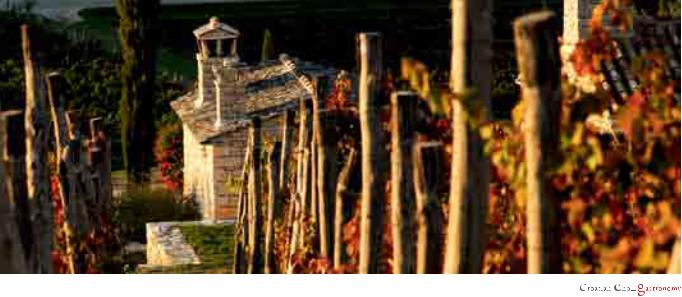
These are usually much flavoured, semisweet or sweet wines, produced from regular picking or some traditional procedures typical of the production of dessert wines. In this way, the grapes are usually left on the vine to become over ripe, possibly until the end of October or November, or are additionally dried after picking. Teran (or Terrano) is the leading red variety in Istria. It gives usually well coloured, aromatic wine, pleasant and fresh, with a tart taste. The best Teran wine is produced in central Istria, around Motovun. In good years, and with moderate vinification, these wines are among the best this variety can give. Refosk (refosco) is a type of variety close to Teran, and was therefore considered for that wine for a long time. Still, they differ. Refosk is less prominent, but gives wine of similar characteristics and is also considered a native variety and a trade mark of red Istrian wines.
Cabernet Sauvignon, Cabernet Franc and
Merlot are world-known varieties, and they are widespread in Istria where they achieve excellent results and are used on their own or as a cuvée. They are grown all over the peninsula, but the best vineyards are found in the western, warmer part, close to the sea. The largest plantations are around Poreč. Their wines are full, medium strong, well coloured and with a discrete, distinctive flavour. Red Pinot is less well represented, but it gives good wines. They are fuller and of better colour than those from inland. It gives the best results in the production of Istrian sparkling wines, together with Chardonnay and Istrian malmsey. Hrvatica (a woman of Croatia) is a less represented variety. It is considered an indigenous variety, gives a good crop and its wine is in the middle quality range. Borgonja is another variety considered as autochthonous, although, for a while, it was thought to be identical
to the French Gamay. Still, genetic research has discarded this hypothesis, and has established that this variety is identical to Frankovka (a dark-skinned variety), i.e. the
Blaufrankisch or Lemberger variety. It gives good, red wine, of moderate fullness and colour, very appropriate for everyday use with many Istrian traditional dishes. The Muscat Ruža of Poreč is a local synonym for a more famous Austrian Rosenmuskateller or the Italian Moscato Rosa, an old variety of rather particular features; it gives excellent, mostly dessert wine, whose bouquet reminds us of roses. The wines are semi-sweet or sweet, of very intensive bouquet, moderately coloured and of full taste, balanced and with very long ending. Besides the varieties mentioned above, which form the majority in the vineyards of Istria, we can also mention draganela, brajdenica, opačevina, dolcin, duranija, surina and some other varieties, which are today almost forgotten. They are not used separately, but as part of a mixed, mostly old plantations. We consider them the native varieties and measures have been taken lately to revitalise them.
Principal producers
According to many indicators, Istria is one of the leading Croatian wine-growing regions. The number of producers is on the rise, and the areas covered with grape-vines are expanding. Most of them are located in western Istria and the majority are small wine cellars, companies and family farms. During the 90s of the last century, a new Istrian wave started from here. A few young producers started production in a new, modern way and have quickly risen to the Croatian peak. They are successful on the world markets today and their products are often given excellent marks and receive awards. Among them, distinguished are the Matošević (with famous, recognised malva-
sia Alba and Alba barrique, Grimalda, excellent Cuvée Chardonnay, Sauvignon and Istrian malvasia) and Kozlović (with Santa Lucia, from the location of the same name, is one of the most sought after malvasias, and semi-sweet Momjanski Muscat in the category of dessert wines), but also Coronica and Trapan, who have been attracting world attention lately with their malvasias. There are also the Pilato, Degrassi, Arman and a dozen other less known, but perceptive wine makers.
The largest producers are the Agrolaguna and Istravino. They offer many varieties of wine of moderate price and good and excellent quality (particularly Merlot and Cabernet Sauvignon of the Agrolaguna, and Teran Dajla of the Istravino). It is important to mention also the wine maker Roxanich and Franco Arman, whose wines have recently been positioned among the best Istrian teran wines. Some of the best Croatian sparkling wines are produced in Istria, under the name of Misal, where we find several sparkling wines produced in a traditional procedure of bottle fermentation. Besides the usual varieties of chardonnay and red pinot, produced in the traditional, champagne method, the native Istrian varieties are also being vinificated, making those wines rather specific and interesting.
The Association of Vine and Wine Growers, Vinistra, is largely responsible for the development of vine-growing and wine making in Istria. They organise regular exhibitions of wine, Vinistra, (at the beginning of May) and the international competition, The World of Malvasia, which is a sort of a world championship of wine produced from different malvasias. They have initiated the programme Malvasia IQ, the system for awarding a specific marking IQ (Istrian Quality) to the best malvasias. In this way, they promote and raise the quality of the most important Istrian wine.
22

1_istria |
23 |

The area of Kvarner is the home of shrimps, one of the biggest sea delicacies in the world
2k v a r n e r
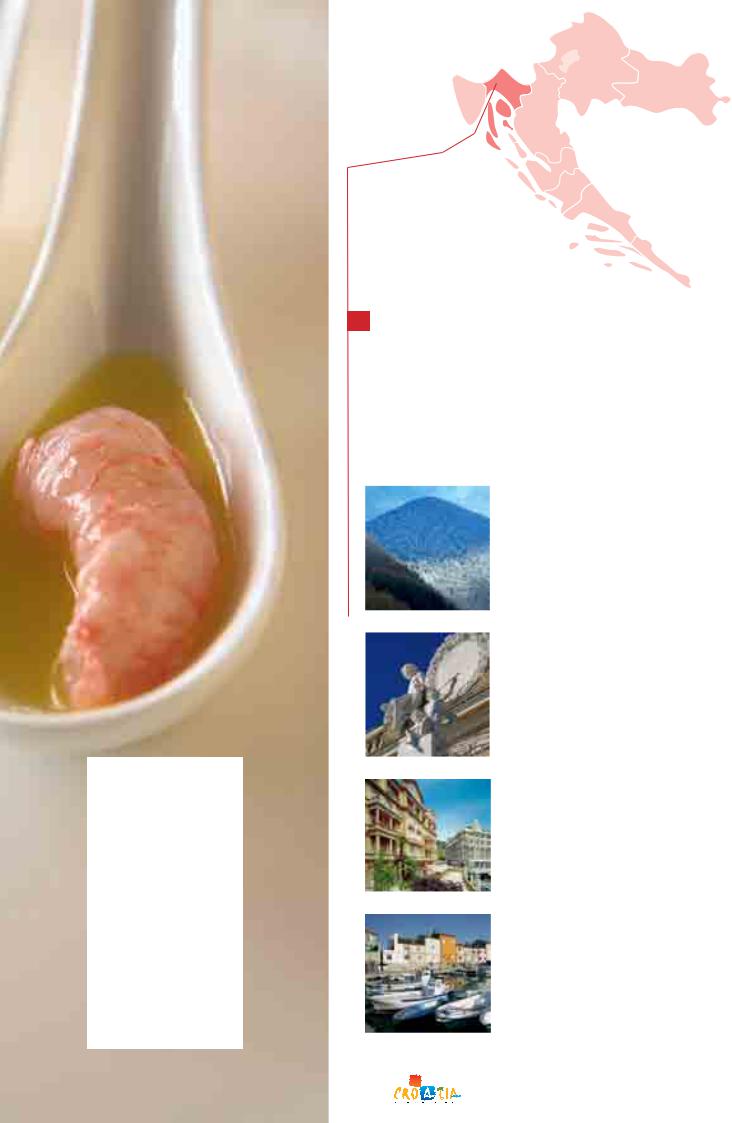
Did you know?
Kvarner gastronomy is embracing the famous Lovran chestnut from the slopes of Učka Mountain. This is a much valued variety of chestnut and it is the basis of the seasonal offering of sweet delicacies made from this fruit. Every autumn, the festival of chestnuts, called Marunada, takes place in the town of Lovran, celebrating the season of the chestnut and offering a wide range of delicacies made of or with chestnuts.
2 Kvarner area offers several restaurants singled out for their consistent quality standards and constant innovations with seasonal features.
Even if the famous Kvarner shrimp was the only thing Kvarner gave to the Mediterranean gastro-culture, it would have been enough for its place at the gastronomic map of the world. Many experts in gastronomy and gourmands have no doubts: the Kvarner shrimp or the shimp from the area under the Velebit Channel originally comes from Norway and has become domesticated in the area of Kvarner. Its quality is extraordinary and its extremely delicate, gentle texture surpasses all crabs and, many would agree, even the lobster and hlap (a type of lobster) and the pretty rare sea-spider from Pula’s local waters. It lives on the muddy soil, but excessive catching is threatening this species. The king of crabs can be prepared in several ways, and some of the master chefs consider that its basic preparation includes a 2-minute cooking in mildly salted water with a bit of olive oil. Served with sprinkled olive oil and a few drops of lemon, shrimp’s fascinating taste is preserved. Its genuine taste is also preserved by short barbecuing and many will opt for buzara (stew), scampi risotto or pasta with scampi. Any way of preparation of a large, fresh shrimp brings one of the biggest, global sea delicacies to the table. Devotees of the original authenticity of taste eat shrimps raw sprinkled only with a few drops of lemon juice.
The area of Kvarner, and specifically the Opatija Riviera, has several restaurants singled out with consistent quality and constant innovations with seasonal features. The tables of those restaurants will offer the most quality seasonal fruits and vegetables, and sophisticated sweets, along with imaginatively prepared fresh fish, shells, molluscs and crabs. At the sea side, one will find the
25

Lovers of the original authenticity of taste eat shrimps raw sprinkled only with lemon juice.
Plavi podrum (blue cellar), Le Mandrac and Tramerka (in Volosko), restaurants Bevanta, Laurus (in Opatija), Johnson (Mošćenička Draga). The best known gastronomic destinations on the slopes above the Kvarner are restaurants and hotels Kukuriku (in Kastav) and Draga di Lovran in the town of the same name. Catering competition in Kvarner resulted in an extensive range of cuisine and a strong tendency towards authenticity in the menus and thus the whole of the Kvarner area can be considered as the peak of Croatian catering.
26
Delicacies of Kvarner’s islands (Krk, Lošinj, Cres and Rab) are strongly represented in Kvarner’s gastronomy. This is specifically the case for lamb ‘à la islands’, which is of extraordinary quality firstly due to variety of pasture, enriched with posolica (traces of salt on the grass from the action of sea winds), and microclimatic characteristics of the Velebit Channel. Smaller island producers of goat and sheep cheeses, usually family farms, continuously improve and enrich the gastronomy of Kvarner with their products. A specific type of pasta, locally called šurlice, is prepared on the Island of Krk, while a type of cream soup of fennel, called mineštra, is prepared on the Island of Lošinj. Krk is the homeland of Vrbnička žlahtina, a famous sort of white wine originating from Kvarner, coming from the area Vrbnik. Along with other delicacies from Rab, comes Cake of Rab, a dessert of fine taste and desired on tables in many prestigious restaurants.
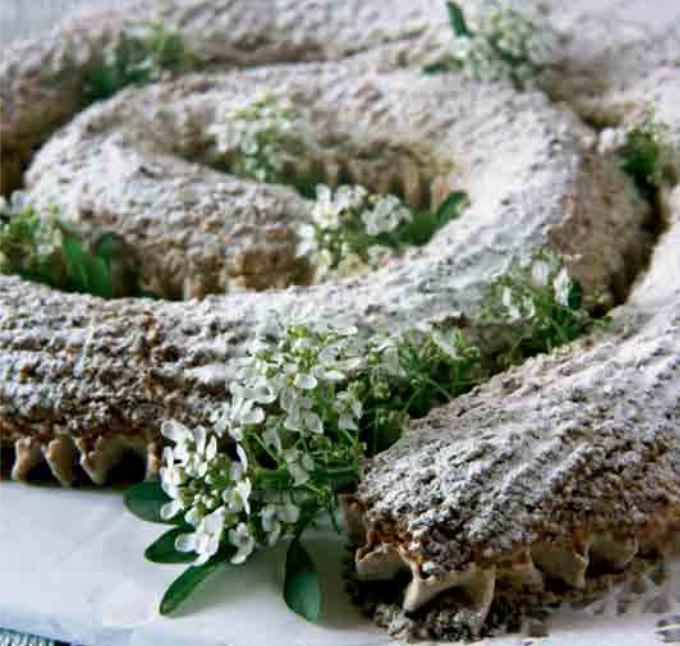
The Kvarner gastronomy is embracing the famous Lovran chestnut from the slopes of Učka Mountain. This is a much valued variety of chestnut and it is the basis of the seasonal offering of sweet delicacies made from this fruit. Every autumn, the festival of chestnuts, called Marunada, takes its place in the town of Lovran, celebrating the season of chestnut and offering a wide range of delicacies made of or with chestnuts. Thanks to its entertaining and gastronomic features, it has grown into a real tourist attraction.
The coastal area is firmly connected to its hinterland, and the Mediterranean cuisine is enriched by continental specialities of the Gorski Kotar, the area known for its game, frogs, snails, dormice, wild fruit and plentiful edible mushrooms. During the summer heat, the visitors of Kvarner have the option of an easy escape into a fresher zone: only a half an hour drive by motorway takes them to the attractive tourist destinations in Gorski Kotar. They can visit the Risnjak National Park, or enjoy
the lakes, tasting specialties offered in the restaurants in Fužine, Lokve and other locations. The long tourist tradition of the Kvarner Riviera, with Opatija as its centre, along with many other towns recognised as coastal resorts, has developed an exciting and sophisticated gastronomy, with prevailing Mediterranean cuisine, but also a strong influence of the traditional cuisine from the areas bordering the coast.
The elements of the central European cuisine, specifically when looking at the confectionery element, are harmonised with typical Mediterranean menus,that are dominated by fresh fish and sea-food. Štrudel (a type of pastry) is equally favoured as fritule (a type of doughnut) and kroštule (a type of sweet pastry). Closeness to Italy and centuries-long connection between Italy and Kvarner have had a strong impact on the gastronomy. The harmonious penetration and completion of traditional recipes, imaginative pasta with sea fruits, vegetables and mushrooms, as well as risotto, eliminates the
gastronomic borders between the western and eastern coasts of the Adriatic sea. Fast tourism development strengthens the tendencies of gastronomic internationalisation, opening its doors to new culinary experiences.
The area of Kvarner is a true paradise for navigators, and they have the opportunity to discover not only the hidden bays with virgin beaches, but also small family-run wine cellars and restaurants, offering local, seasonal specialities and, for some folk, almost forgotten dishes. These are the places where you can experience the Adriatic coast as it once was and as many would like to see it today. This is especially true when talking about the gastronomy, where the folk cuisine is facing more demand and value.
The Kvarner shrimp, symbolising the peak of Kvarner’s gastronomy, will become more rare, and with the time will have to be added to the list of more accessible seafood such as anchovies, sardines and other Adriatic treasures, which are often unjustifiably left out of family and restaurant menus.
2_kvarner |
27 |
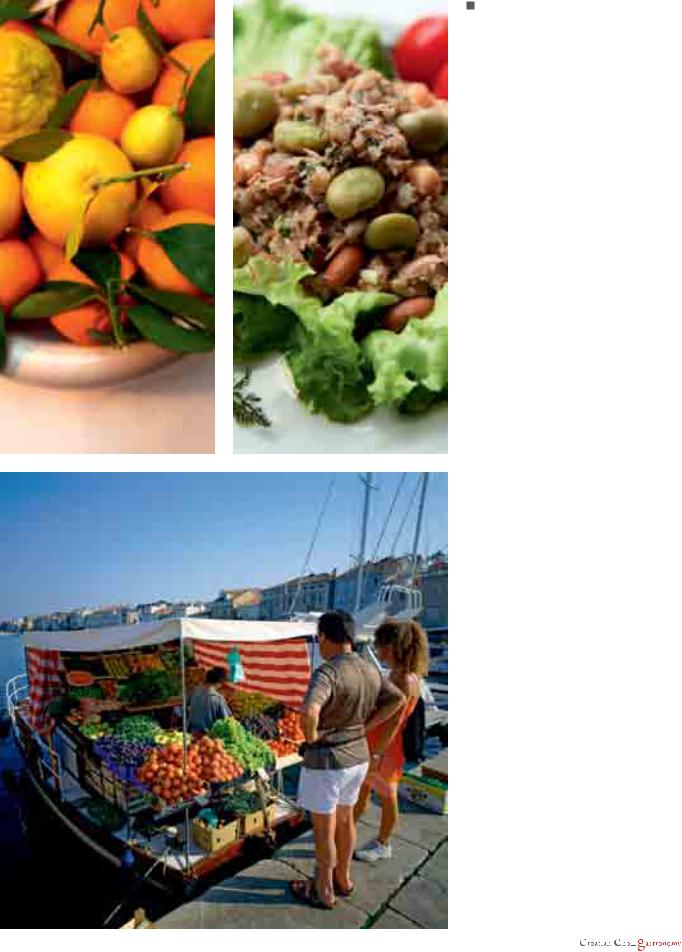
health
Anything you order during your Kvarner travels, will bring the pleasure of taste, but also guaranteed fast recovery and replacement of energy we mercilessly waste in our fast lifestyle.
We are witnesses of the negative impact that stress has on our body and soul. Stress and free radicals are the root of accelerated ageing, but also many degenerative changes. If we take an occasional break and spend quality time while on vacation, we can significantly decrease the unwanted footprints left by the daily turbulence of life. Asparagus (vitamin C, carotene, iron, phosphorus, potassium, asparagines, arginine), citrus fruits (terpene, flavan-3-ols, glucaric acid), wild fruits and nuts (fatty acids Omega 3, minerals zinc, calcium) are just a few foods which contain nutritive components, and can postpone degenerative processes in the cells.
Visiting Kvarner, you get a chance to enjoy natural anti-ageing food with perfect gastronomic pleasure.
groceries
Asparagus
Chestnut
Ramsons Blackberries Lemon, orange
dishes
Squid with swede
Bouillabaisse (brudet) of drysmoked octopus
Lemon risotto
Bitter orange marmalade Grilled scampi
28
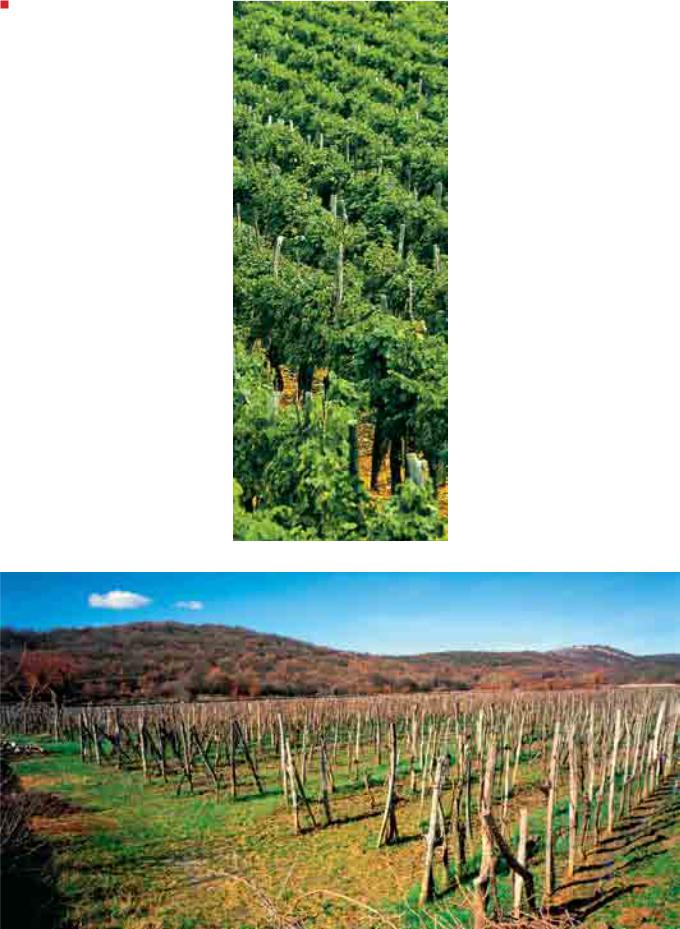
wi n e s
The Croatian coast is a very interesting area for the grapevine; a narrow coastal line between Istria and Dalmatia, between the mountainous Croatia and cold, continental climate and Kvarner’s isles with its typical Mediterranean atmosphere. Every traveller visiting this region, immediately notices its differences in landscape, climate, vegetation and the way of life within a relatively small space, where it is possible to spend the morning skiing at the Mt. Platak, and a few hours later enjoy the sea under the warm sun. The production and availability of wine are diverse and it is possible to find chardonnay, pinot and frankovka of almost continental freshness in the Vinodol area (from Križišće to Novi Vinodolski), while islands also grow typical southern varieties, such as cabernet sauvignon, merlot, syrah, and recently the plavac mali (small blue grapes).
The history of grapevine cultivation is very old and goes back to ancient times. The Greeks were probably the first who started producing wine, but the most important for the development of viticulture were the Romans. Proof of this is found in numerous documents, including a record of Lucan, a Roman poet, who speaks about the fight between Caesar and Pompey on the Island of Krk, and of the wooden barrel made of alder, which Caesar’s soldiers used to escape from the surrounded island. This leads us to conclude that the habitants of this area used wooden barrels before the Greeks and Romans did. The latter are recorded as more important for the development of viticulture, although they kept and transported their wine in clay amphora.
Wine-growing fields and production conditions
In accordance with Croatian wine legislation, the area of Kvarner belongs to the wine-growing Croatian coastal region, and the most significant areas are at the sea side (the wine growing fields cover the whole coastal area from Lovran to Vinodol), as well as the islands, starting with Krk and Rab. Other islands have mostly smaller family farms and the Island Susak is worth mentioning because it emerged from the alluvium of sand, and at the beginning of the 20th century, the grape-vine covered up to 96% of the area of the island, i.e. everything except the villages (there was no vine-pest on the island). This demonstrates the significance of this culture for the economy of Kvarner’s islands.
The vineyards are located mostly on karst fields and on terraces to a lesser extent. The most famous of them are in the area of Bakar, where the production of the first sparkling wine in this area started. It was the famous “Water of Bakar” (copper water – Bakarska vodica). The soil is very diverse; from heavy red soil to light flysch and sand. The differences in climate between the coastal area and islands are also very marked. In Rijeka there is about >1500 mm/per year of precipitation, while Susak has about half of that, i.e. around 800 mm. Temperatures also vary, but the annual average is around 14-15 °C. All these differences result in the development of a large number of varieties
2_kvarner |
29 |
